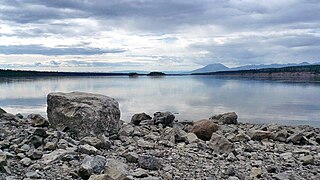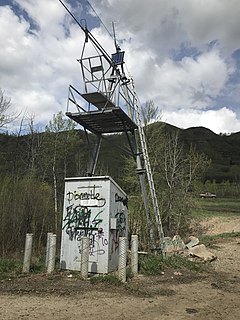
The Peace River is a 1,923-kilometre-long (1,195 mi) river in Canada that originates in the Rocky Mountains of northern British Columbia and flows to the northeast through northern Alberta. The Peace River joins the Athabasca River in the Peace-Athabasca Delta to form the Slave River, a tributary of the Mackenzie River. The Finlay River, the main headwater of the Peace River, is regarded as the ultimate source of the Mackenzie River. The combined Finlay–Peace–Slave–Mackenzie river system is the 13th longest river system in the world.

The Liard River of the North American boreal forest flows through Yukon, British Columbia and the Northwest Territories, Canada. Rising in the Saint Cyr Range of the Pelly Mountains in southeastern Yukon, it flows 1,115 km (693 mi) southeast through British Columbia, marking the northern end of the Rocky Mountains and then curving northeast back into Yukon and Northwest Territories, draining into the Mackenzie River at Fort Simpson, Northwest Territories. The river drains approximately 277,100 km2 (107,000 sq mi) of boreal forest and muskeg.

Peace River South is a provincial electoral district for the Legislative Assembly of British Columbia, Canada. It was created under the name South Peace River by the Constitution Amendment Act, 1955, which split the old riding of Peace River into northern and southern portions for the 1956 BC election. Its current name has been in use since 1991.

The Beatton River is a tributary of the Peace River, flowing generally east, then south through north-eastern British Columbia, Canada. The river rises at Pink Mountain, about 10 kilometres (6 mi) west of the Alaska Highway hamlet of the same name, and flows 240 kilometres (150 mi) generally east, then south, draining into the Peace River just downstream of Fort St. John. The river meanders mostly through the boreal forest and muskeg of the Peace Plain. Its major tributaries are the Doig and Blueberry Rivers.
Babine Mountains Provincial Park is a provincial park in British Columbia, Canada, located to the east of the Bulkley River between the town of Smithers (SW) and Babine Lake (NE). Established by Order-in-Council as the Babine Mountains Recreation Area in 1984, it was upgraded to park status and its name changed in 1999. It contains approximately 31,465 hectares.
Babine River Corridor Provincial Park is a provincial park in British Columbia, Canada, located to the north of Hazelton. The park was established by Order-in-Council in 1999 and is approximately 15,339 hectares in area.
Bearhole Lake Provincial Park is a provincial park in British Columbia, Canada, located 5 km east of the mining community of Tumbler Ridge, on the Alberta Plateau. Established in January 2001, the park includes 12,705 ha of land in the Boreal White and Black Spruce biogeoclimatic zones within the Kiskatinaw Plateau. It is transition zone with mixed wood forests including spruce, pine, and larch. Bearhole Lake, the headwaters of the Kiskatinaw River provides habitat for trumpeter swans, yellow perch, burbot, rainbow trout, and northern pike.

Beatton Provincial Park is a provincial park in the Peace River Country of northeastern British Columbia, Canada.
Beatton River Provincial Park is a provincial park in the Peace River Country of northeastern British Columbia, Canada.
Butler Ridge Provincial Park is a provincial park in British Columbia, Canada. Located on the northern shore of the Peach Reach arm of Williston Lake, 20 km northwest of Hudson's Hope, the park covers an area of 6,694 ha. Within the Peace Foothills ecosection, it includes three biogeoclimatic zones: the Engelmann Spruce-Subalpine Fir, the Sub-Boreal Spruce, and the Black and White Boreal Spruce zones. This cold and moist area is used as winter ranges by caribou, Stone's sheep, moose, and elk. It is recognized by the province and the Treaty 8 Tribal Association as an area that has traditionally been used by First Nations people. The park is used for fishing, hunting, trapping, hiking, and wildlife/nature viewing, cross-country skiing. There is a boat launch for Williston Lake, and motorized recreation.

Cathedral Provincial Park and Protected Area, usually known as Cathedral Provincial Park and also as Cathedral Park, is a provincial park in British Columbia, Canada. It is located east of E.C. Manning Provincial Park, south of BC Highway 3, and southeast of the town of Princeton and southwest of Keremeos. Its southern boundary is the border with the United States. Much of the park is the basin of the Ashnola River.
Charlie Lake Provincial Park is a provincial park in British Columbia, Canada, established on the western shore of Charlie Lake. It is roughly 92 hectares in size.
One Island Lake Provincial Park is a provincial park in British Columbia, Canada.
Wapiti Lake Provincial Park is a 16,837-hectare (41,610-acre) provincial park in British Columbia, Canada. It is 60 kilometres (37 mi) south of Tumbler Ridge, at the headwaters of Wapiti River, including its watershed from the Wapiti Pass to Wapiti Lake in the Canadian Rockies. The area contains significant amounts of fossils (ichthyosaurs) and fossil beds. There is habitat for grizzly bears, mountain goats, and bull trout. It was established as a Provincial Park on June 26, 2000. It is recognized by the provincial government as being an area traditionally used by First Nations people. Hunting and fishing are permitted in the park.
Porcupine Meadows Provincial Park is a 2,704 hectare provincial park in British Columbia, Canada, located north of Tranquille Lake to the northwest of Kamloops. Its name is a direct translation of the Shuswap word for this area, "pisitsoolsia", named so for the numerous porcupine in the area.

Stemwinder Provincial Park is a provincial park located just west of Hedly in British Columbia, Canada. The park is 4 hectares in size, and provides public access to the Similkameen River.
Taylor Landing Provincial Park is a provincial park in British Columbia, Canada.
Clayhurst is a rural community in British Columbia, located just north of the Peace River and just inside the British Columbia-Alberta boundary.

Rainbow/Q'iwentem Provincial Park is a recently established 385 hectare provincial park in the Cariboo region of British Columbia. The park was established in 2013, protecting the land between Sulphurous Lake and Deka Lake. While there are no developed trails in the park, existing routes used by locals exist connecting roads on the North Shore of Deka Lake to the North Shore of Sulphurous Lake. The park is accessible by road only from the southwest.
Donnely Lake Provincial Park is a BC Parks and former recreation site located in the Cariboo Regional District of British Columbia. The park was established in 2013. The park entirely surround Donnely Lake, directly north of Deka Lake. A single trail from the former recreation site of the same name leads between Bowers Lake Forest Service Road and the lake, providing access for camping and fishing.








